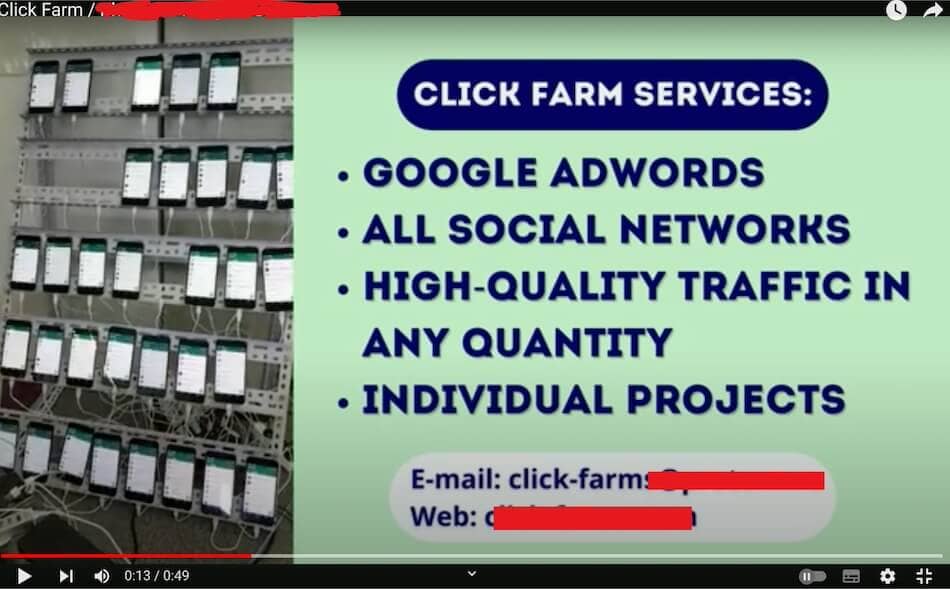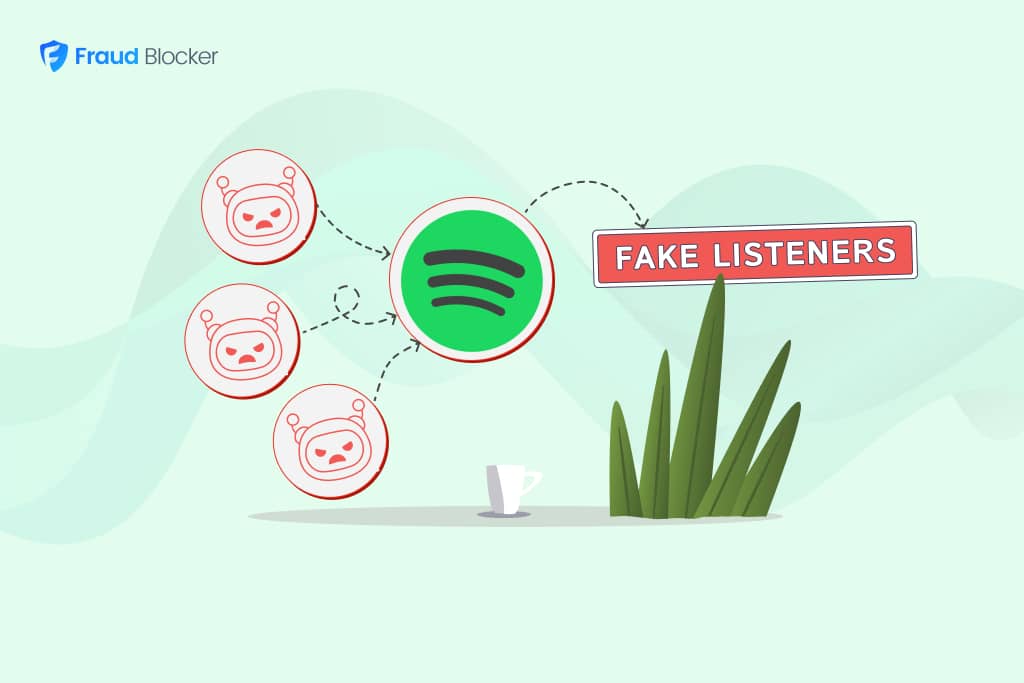
NEW New feature: Verify & block fake emails

We improve your ad performance by blocking click fraud and fake emails

Click fraud is costing advertisers billions in loses. Learn more here.

Click fraud is costing advertisers billions in loses. Learn more here.


Click farms are service providers who offer bulk traffic to websites for a fee. This traffic can be used for everything from inflating social media engagement metrics, to fraudulently clicking on ads for profit.
These click farms often avoid detection by showing legitimate visitor behavior, like browsing the site or signing up for a newsletter. They’re considered a significant upgrade from
click bots.
Fraudulent clicks are problematic for PPC advertisers who have to pay for every click on their ads. The advertisers enter these pay-per-click (PPC) agreements with the expectation that they’ll have a reasonable conversion rate, resulting in a decent return-on-ad-spend (ROAS). Farms are typically located in developing countries like China and India and pay meager salaries.
The classic image of a click farm is usually of a group of workers, often in low income countries, sitting behind rows of desktop computers performing repetitive click based tasks. And while there is some element of truth to this, click farms have evolved in recent years.
These days there are several different types of click farm, including:
These are large scale operations, often using a mixture of human workers and networked devices to generate high volumes of fake internet traffic. Typically, these types of click farm are used to boost social media engagement, inflate ad clicks (click fraud) or to post spam comments, usually linked to either disinformation and troll factories, or black hat SEO practices.
One of the most lucrative uses for these click farms is to perform high level ad fraud. This is where traffic is routed to websites and designed to click on banner ads or watch video ads, inflating the publisher’s payout.
The human workers can often be used to bypass CAPTCHAs or perform an action that is then copied by the thousands of networked devices.
These click farms often use proxy servers and VPNs to evade detection and appear to come from a specific location. If you’ve ever run a search for ‘buy web traffic’, you’ll see these services offering bulk clicks from locations such as the USA or Europe. But despite their claims of being ‘genuine traffic’, they are actually 99% bot activity.
While industrial scale click farms are often run by organized criminals, there is also a booming industry in smaller cottage-industry style click farms. These are where an individual, or a small group of people, set up a simple botnet running old smartphones or tablets.
These can then be used to perform a single specific task, such as boosting likes on social media platforms or performing click fraud on display ads.
A famous example of this is a Chinese gang busted in Thailand who were inflating clicks on WeChat, a popular Chinese social media site.
Small click farm operators often sell their services openly on sites such as Fiverr or social media sites. Here’s an example of a click farm advertising openly on YouTube.

The term bot farm is often used interchangeably with click farm. And although they are technically a form of click farm, there are some subtle differences between the two.
Typically a bot farm is multiple devices, often cheap smartphones, that are running a bot script. This is usually a more simple version of the human/bot hybrids in modern industrial click farms. Technically a bot farm is simple automated traffic designed to inflate views on Twitch streams or YouTube videos, click like on a social media post or follow a specific account.
You’ll often see references to bot farms in relation to social media disinformation. But these are actually genuine click farms, using human workers alongside automated scripts
A botnet is a network of connected devices which are usually not in the same location, but often scattered around the world. The bot has usually been spread via malware, or a virus, meaning that the user of the device is totally unaware of the presence of the bot in their device.
This form of malware can be embedded within a browser extension, app or often downloaded via an infected email attachment.
Malware bots can be used for a wide variety of purposes, from launching DDoS attacks to ad fraud. And because they are coming from a genuine user’s device, they can be hard to spot.
An example of a malware botnet in use is with the Methbot and 3VE ad fraud campaigns, which used Kovter and Boaxxe malware.
Due to the profitable nature of creating fake web traffic, several companies have started offering out of the box click farms, or the Box Phone Farm. As the name suggests, this is typically a circuit board equipped with the internal workings of an average 20 smartphones, with the screens and batteries removed.
This board is then installed into a desktop server where software is then used to load up the devices. For fraudsters, this means that there is less power consumption, with no need to power up multiple device screens, and of course no need to buy multiple devices. These phone farms are often much cheaper and more reliable than buying multiple phones – and of course you can have more of them in a smaller space.
And because they are not running a full device, the lifetime is typically longer too, allowing the click farm operator to run these devices for longer.
Although not technically a click farm, paid to click (PTC) websites are a popular way for people to earn money in low income countries. They work by creating an app or website which is loaded with ads.
People then sign up to earn money on these websites (hence: paid to click) and are then paid for watching videos, clicking ads or completing forms.
Although they are fraudulent by definition, some of these sites are more genuine than others. Some PTC sites do actually pay out, often a few dollars for hundreds of clicks. However others will set up a site, offer very tempting payouts and then disappear after a few weeks or months without ever paying out to their poor clickers.
The operator obviously pockets all the profits from their low paid workers’ hard work – at the expense of both the advertiser and their farm workers.
Click farms can be used for various online practices that require web traffic. These can include:
Read more: What is click fraud?
In general, the setting up of a click farm is not actually illegal. However, many of the practices associated with click farms either fall under a legal gray area, or are outright illegal.
Some of the illegal practices include:
Most click farms are also based in countries where the law is loosely applied, if it’s applied at all. For example, many click farms are found in countries such as China, India, Vietnam, Indonesia, the Philippines, Eastern Europe, Africa, and Bangladesh. Given the low cost of purchase and the geographical spread, we know click farming is prevalent in advertising and social media.
Recently, photographer Jack Latham visited several click farms in Vietnam, offering a rare but fascinating glimpse into this shadowy world. Read the article on CNN.
The Today Show also produced a great report with real videos of click farms in action:
Click fraud is a billion dollar industry, with estimates putting the cost at between $60 billion to $100 billion each year and rising. And click farms are instrumental in the effective running of any click fraud campaign.
The sheer volume of clicks and fake traffic needed is beyond most humans.
When it comes to Google Ads or Facebook Ads, the impact of fake clicks can be huge.
The average cost to advertise on Google Search is $1 to $2 per click. When a click farm generates thousands of clicks on a victim’s paid ads, they will have to pay thousands of dollars without any hope of recovering that money through customer conversions. Click fraud, including other types like bots, cost eCommerce businesses $3.8 billion in 2020, and affects 87% of companies today.
Yes, it’s possible to spot many forms of activity from click farm traffic. One of the most common ways is by tracking IP addresses.
Click farms do use proxy servers and VPNs to hide their location, but will often switch between a range of specific IP addresses. While there can be hundreds or thousands of them in use by a single location, spotting and blocking IP addresses associated with click farms can be a quick way to stop them interacting with your paid ads.
Another method is by tracking bot activity. While bots can mimic some human behavior, fraudulent traffic from bots will often have a high bounce rate or can even come from headless browsers. These are computers or devices that have no screen, meaning they can’t be operated by a human.
Bot traffic also uses a lot of mismatched data, such as country of origin or even device information. This can be a strong indicator of fraudulent traffic and potential click farm activity.
As we’ve seen, click farms can be very sophisticated and hard to spot using manual processes. Click fraud prevention software is the most effective way to detect and block click farm traffic in real-time.
Fraud Blocker saves your marketing budget by eliminating human and non-human traffic sources that drain your ad spend. Our proprietary algorithms are as sophisticated as the ever-evolving click fraud technologies. They can detect the atypical behaviors associated with click fraud and protect your business.
If you have any concerns about invalid traffic sources draining your ad spend, contact us to find out how our click fraud prevention software could save you money.


